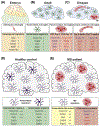Fifty Shades of Microglia
- PMID: 31005331
- PMCID: PMC12124195
- DOI: 10.1016/j.tins.2019.03.010
Fifty Shades of Microglia
Abstract
In a recent study, Masuda and colleagues (Nature 2019;566:388-392) used single-cell RNA-sequencing (scRNA-seq) to profile microglia across different anatomical compartments, developmental stages, and types of brain pathology in mice. Moreover, the authors performed a novel transcriptomic characterization of microglia from multiple sclerosis patients and identified phenotypically conserved microglial subsets between species. These findings, together with seminal prior results from various groups, provide valuable insights into the spatiotemporal heterogeneity of microglia during brain development and disease.
Keywords: cuprizone model; facial nerve axotomy; microglial transcriptomic signature; mouse and human microglia; multiple sclerosis; single-cell RNA sequencing.
Copyright © 2019 Elsevier Ltd. All rights reserved.
Conflict of interest statement
Marco Colonna is recipient of research funds from Alector, Amgen, and Ono
Figures

Comment on
-
Spatial and temporal heterogeneity of mouse and human microglia at single-cell resolution.Nature. 2019 Feb;566(7744):388-392. doi: 10.1038/s41586-019-0924-x. Epub 2019 Feb 13. Nature. 2019. PMID: 30760929
References
Publication types
MeSH terms
Grants and funding
LinkOut - more resources
Full Text Sources
Medical

